
Our Instruments
Hurdy-Gurdy
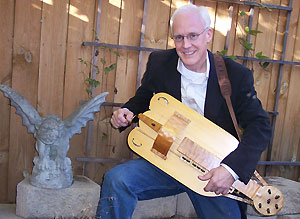
 The Hurdy Gurdy, called Vielle à Roue in French and Drehleier in German, is currently enjoying a re-birth,
especially for early music. The instrument that you see here was built by Lyn Elder in Vermont. It is a recreation of the instrument
depicted in the famous 1504 alterpiece by Heironymous Bosch, shown at the right. Nearly all of the hurdy-gurdys that you see today are 19th-century French style instruments with a lute back or guitar-shaped back. I explained to Lyn that I wanted an instrument that would be appropriate for medieval music. Voilà!
The Hurdy Gurdy, called Vielle à Roue in French and Drehleier in German, is currently enjoying a re-birth,
especially for early music. The instrument that you see here was built by Lyn Elder in Vermont. It is a recreation of the instrument
depicted in the famous 1504 alterpiece by Heironymous Bosch, shown at the right. Nearly all of the hurdy-gurdys that you see today are 19th-century French style instruments with a lute back or guitar-shaped back. I explained to Lyn that I wanted an instrument that would be appropriate for medieval music. Voilà!
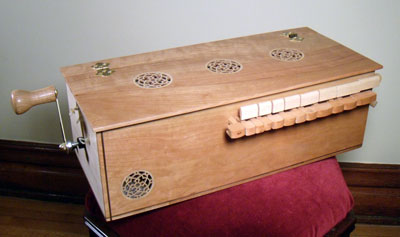
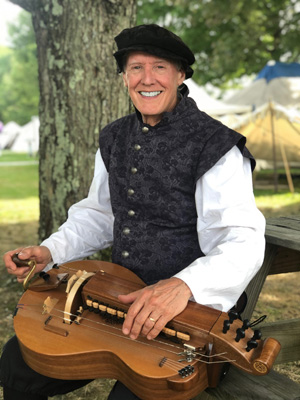 At left is a more modern gurdy, typical of instruments being made in Europe, that I use for Renaissance and Medieval fairs of one sort or another.
At left is a more modern gurdy, typical of instruments being made in Europe, that I use for Renaissance and Medieval fairs of one sort or another.
At right is the magnificent medieval Symphonie. It has two melody strings, two drone strings and no trompette or "buzzing bridge". This style of hurdy gurdy is commonly depicted in iconography of the 10th through the 15th centuries. It has a sweet, quieter tone than the larger Bosch instrument or the more modern gurdy, both of which have a trompette.
Viola da Gamba
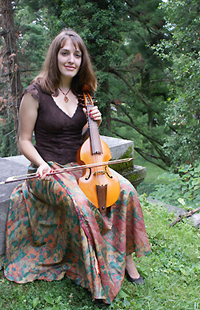 Lindsay with a Treble Viola da Gamba.
Lindsay with a Treble Viola da Gamba.
The viol first appeared in Europe in the late 15th century in Spain and Italy. The Italians brought it to England and other countries where it became one of the most popular Renaissance and Baroque instruments. Viols were heard primarily in ensemble, or consort, music. Unlike the violin or cello bow, the viol bow is held with an underhand grip, allowing viol players to use their fingers to control the bow and govern the tension of the horse-hair. Like the lute, the viol has tied on gut frets which can be moved up or down the neck to accommodate different tuning systems. Early viols had four or five strings. The Renaissance viol more commonly had six gut strings.
Around 1660, strings with wound copper wire became available and were often used for the lower-pitched bass strings. The gut gives viols a sweeter, more mellow sound than modern cello and basses with steel strings. Viols were most often played in a group with other instruments, sometimes with dissimilar instruments but often with other viols of different sizes. Viols were built in many different sizes and string configurations, including Pardessus (high treble), Treble. Alto, Small tenor, Tenor, Bass, and Violone (contrabass).
The Viol is currently enjoying a resurgence in popularity. Interested readers should look into the Viola da Gamba Society of America.
Medieval and Renaissance Recorders
One of our main interests is acquiring instruments that are as authentic as possible, and then seeing how they suit the music. Since the 1960's, many well-known early music groups have recorded medieval music on instruments that were not invented until 300 years later. Since our group is not driven by the need to earn a living with early music, we have the luxury of exploring early music within the limits of the musical resources that were actually available to medieval musicians. In this way, we hope to discover some things about the music in performance that might not otherwise be evident.
The sound of Renaissance recorders often surprises people who are accustomed to the thinner, penetrating sound of the more common Baroque recorders. Renaissance recorders have a larger, more cylindrical bore than Baroque recorders. They are noticeably louder in the lower register than Baroque instruments, making them better suited for consort use. The Baroque recorder was more of a solo instrument, and was designed to have higher notes with a thinner, more reedy sound. Renaissance recorders feature a much plainer profile with almost no decorative turnings.
We use a matched set of late Medieval / early Renaissance style recorders built by Gary Cook, a recorder maker from England who now lives in Dayton Ohio.
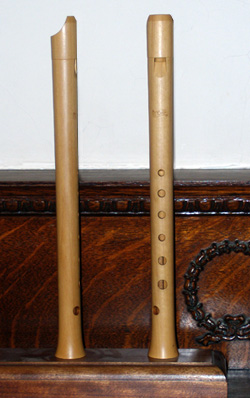
Lutes
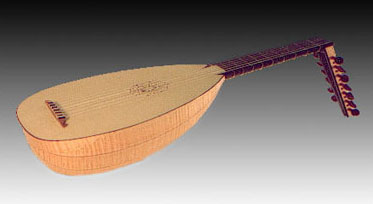 I built the 7-course Renaissance lute that I perform with back in 1980. It is tuned in G, with the lower course tuned to either F or C, as needed. It was modeled after an instrument by Wendelio Venere, 1592. The thirteen course ebony Baroque lute seen elsewhere on this web site is modeled after an instrument by Johann Christian Hoffman. Thirteen ribs of ebony are separated with white holly spacers. It is tuned in D. The medieval lute that I play is discussed more thoroughly on the Medieval Lute page.
I built the 7-course Renaissance lute that I perform with back in 1980. It is tuned in G, with the lower course tuned to either F or C, as needed. It was modeled after an instrument by Wendelio Venere, 1592. The thirteen course ebony Baroque lute seen elsewhere on this web site is modeled after an instrument by Johann Christian Hoffman. Thirteen ribs of ebony are separated with white holly spacers. It is tuned in D. The medieval lute that I play is discussed more thoroughly on the Medieval Lute page.
One of the reasons the lute ruled Europe for 400 years is that the instrument is capable of very fine, precise tuning (in different temperaments) and virtuosos rose who could transport the listeners to a kind of ecstasy. The lute's ravishing tone in the hands of a good player made it the most esteemed and admired of all musical instruments. By the time of the Renaissance, the fame of great players spread throughout Europe and influenced musical styles everywhere. Composers created a solo repertoire that was refined, expressive and extraordinarily rich in compositional techniques, melodies, and even symbolism.
The Medieval lute had fewer strings the the Renaissance lute and was at first used primarily for monophonic (single-line) passages played with a quill or “plectrum”. It wasn’t long before Medieval players began adding extra notes to make simple chords. Playing a three-note chord with a plectrum and playing all three notes simultaneously (not arpeggiated) has been done successfully by modern players, but it is not without challenges. In the late 15th century, players gave up the plectrum and just used their fingers to make chords. Much easier! But it’s also a very different sound. Finger plucking is done without nail and is softer and mellower sounding than playing with a pick. Played with a pick, individual notes stand out sharply when accompanied by other instruments like a drum.
Medieval lute music played with a pick gives an entirely different feeling than the same passage played with the fingers. It seems to hearken back to the Middle Eastern origins of the lute. Instead of a French or English court, one thinks of the Alhambra or one the great Islamic palaces in Spain. So much non-liturgical Medieval music in Europe had ties to Arabic, Persian, and Byzantine influence. The harmonic and rhythmic seeds are there and show up in the improvisations that the Islamic world introduced to Europe.
Baroque Guitar
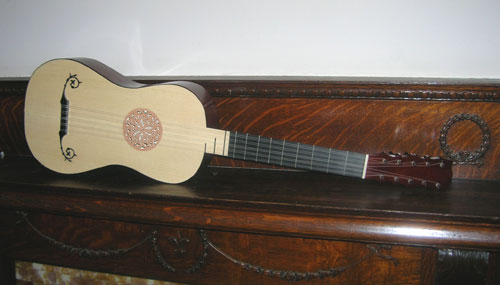
The appearance of the five course guitar in 18th-century Spain produced a sense of abject horror. The guitar and its music was the punk rock of its' day. The new guitar was often strummed rather than plucked like the vihuela or lute. Worse, it was associated with commoners (any stable boy could strum a guitar), popular ballads, taverns, criminality, sensuality and in particular dancing, seen by the church authorities as the sure path to damnation. Public performance of a Zarabanda on a guitar was punished by flogging and a term in the galleys!
It finally received the attention of many great composers of the day, composers like Gaspar Sanz (1640-1710), whose efforts took the guitar out of the taverns and stables and into the royal courts of Europe, where the music would rival that of the lute and vihuela.
Some baroque guitar composers favored a stringing system without basses (bourdons), producing a re-entrant tuning where the two ‘lowest’ strings sound higher than the third. This facilitates the neater execution of decorations and in particular the effect known as canpanellas (little bells), where adjacent notes in runs are sounded on different strings, creating the effect of church bells tolling rapidly (change-ringing). It is impossible to produce this effect on a modern classical guitar. Another advantage of this tuning is the clarity of certain passages. The notes on the 4th and 5th course may be at the same pitch as those on higher strings, but they have a different tone color, which helps pick out the imitation, for example in Marionas. If the lower courses were both tuned in octaves, the music would sound out of joint, with some notes of a scalic passage doubled an octave lower, and other notes not.
It is important to play the music from photo-facsimile editions rather than modern tablatures or worse, modern musical notation. The original publications are not all that difficult to learn and they put you in direct touch with the composer's intentions, especially the ‘rasgueado’ (strummed) and punteado (plucked) notations. Transcriptions also do not take into account the re-entrant tuning and do not indicate which strings that the composer wanted the player to pluck to achieve the wealth of tone colors and expression characteristic of this instrument. The music of Gaspar Sanz, for instance, features campanellas and other rapid passagework together with all manner of trills, slurs and left-hand ornaments. His music is a dazzling display of virtuosity, a quality which is lost if transcribed into modern notation and buried beneath the somber, stately sound of the modern classical guitar.
I built this baroque guitar in December of 2006.
Renaissance Flute

This keyless flute in D was made by Casey Burns in 2005. See www.caseyburnsflutes.com. Museum collections of original Renaissance flutes indicate that they were typically made in one piece (except for the bass, which was two pieces) and that they were often made in families so that the musician could play in different keys. With a D flute, you can really only play in two keys, D and G. There is little evidence for the use of the transverse flute in the Middle Ages and Renaissance. It is typically associated with military bands. The Fife was used with a side drum for dancing or marching. Throughout these centuries the term "flute" meant "recorder."
Around 1670 the flute's design was radically altered by French makers, who added a key and made the bore conical. These flutes were built in three joints. All of these changes extended the range and allowed the player to play in other keys with cross-fingerings. This new flute finally became more popular than the recorder. In the second quarter of the eighteenth century, the flute changed again, acquiring four joints. This allowed it to be tuned more precisely to other instruments. Extra keys did not appear until the end of the eighteenth century.
Vihuela
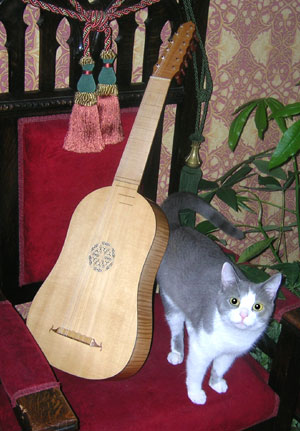 The vihuela
was the most important instrument in 16th-century Spain. Although the
rest of Europe favored the lute, it is speculated that Spain resisted
the lute because of the Moorish invasions. (The lute was descended from
the Arabic la'Oud). The vihuela was tuned exactly like the lute and shared
the lute's repertoire. Even the technique and performing practice was
identical, except for the vihuela's dedillo stroke (rapid up and down
movement of the first finger on one or more strings). The vihuela repertory,
represented by eight composers whose works survived, includes both solo
vihuela music and music for voice and vihuela. Solo music includes intabulations
of sacred and secular songs, fantasias, diferencias (variations) on popular
harmonic progressions and arrangements of Italian madrigals and French
chansons. Dances are extremely rare. The vihuela disappeared from Spain
at the end of the sixteenth century, but the vihuela and the guitar were
both used in colonial times throughout Latin America. I built this one,
based on 16th-century iconography (since there are only two surviving
vihuela-like instruments), around 1980.
The vihuela
was the most important instrument in 16th-century Spain. Although the
rest of Europe favored the lute, it is speculated that Spain resisted
the lute because of the Moorish invasions. (The lute was descended from
the Arabic la'Oud). The vihuela was tuned exactly like the lute and shared
the lute's repertoire. Even the technique and performing practice was
identical, except for the vihuela's dedillo stroke (rapid up and down
movement of the first finger on one or more strings). The vihuela repertory,
represented by eight composers whose works survived, includes both solo
vihuela music and music for voice and vihuela. Solo music includes intabulations
of sacred and secular songs, fantasias, diferencias (variations) on popular
harmonic progressions and arrangements of Italian madrigals and French
chansons. Dances are extremely rare. The vihuela disappeared from Spain
at the end of the sixteenth century, but the vihuela and the guitar were
both used in colonial times throughout Latin America. I built this one,
based on 16th-century iconography (since there are only two surviving
vihuela-like instruments), around 1980.
After the disappearance of the 16th-century Spanish vihuela, the terms guitarra and vihuela were used interchangeably to describe any five-course guitar. In Mexico, the term vihuela is used today to indicate a small, deep-bodied, five-string guitar (with either metal or tied-on frets) played in a Mariachi ensemble. It has no connection, either historically or musically, to the original 16th-century Spanish vihuela. The five-string Mariachi vihuela probably evolved from the five-course baroque guitar, along with most of the other guitars in use in the Americas today.
Listen to Duo Chambure's recording of vihuela duets. Danger! You will end up falling in love with the sound and music of this instrument!
Mr. Gray was concerned that the strings might be catgut. We actually use gut strings instead of nylon on all of our instruments. Besides being more authentic, gut is both more percussive and more mellow than nylon strings. Gut strings "pop" a little more with each pluck and sound infinitely sweeter than nylon. Once you have tried gut, you will never go back to the slippery, dull sound of nylon. And by the way--they're made from sheep intestine, not cat.
Rebec
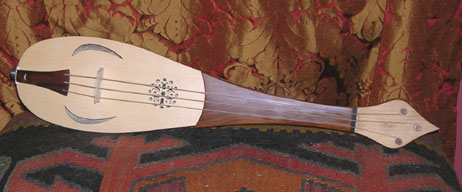 The rebec's origins can be traced to the Persian rebab, which the Crusaders brought back to Western Europe during the tenth century. It became more widely used in Spain, France and Germany by the middle of the 11th Century, and by England and the rest of Europe by the 12th century. The European instrument makers continued to build it the way it was found, with a pear-shaped body and neck carved from one piece of wood. Given the failure of glues, it made sense to build an instrument with as few joints as possible. The number of strings increased from 2 to 3, although some early depictions show 4 or 5 pegs. (It is interesting that the number of strings on instruments in early paintings do not always correspond to the number of pegs. This is simple artistic license.) They are almost never depicted with frets. Like most middle-eastern instruments, the rebec had a wood soundboard rather than animal skin. It is most often depicted being played in a horizontal position at the shoulder, much like the modern violin.
The rebec's origins can be traced to the Persian rebab, which the Crusaders brought back to Western Europe during the tenth century. It became more widely used in Spain, France and Germany by the middle of the 11th Century, and by England and the rest of Europe by the 12th century. The European instrument makers continued to build it the way it was found, with a pear-shaped body and neck carved from one piece of wood. Given the failure of glues, it made sense to build an instrument with as few joints as possible. The number of strings increased from 2 to 3, although some early depictions show 4 or 5 pegs. (It is interesting that the number of strings on instruments in early paintings do not always correspond to the number of pegs. This is simple artistic license.) They are almost never depicted with frets. Like most middle-eastern instruments, the rebec had a wood soundboard rather than animal skin. It is most often depicted being played in a horizontal position at the shoulder, much like the modern violin.
The rebec was little used beyond the renaissance period. A form of the instrument, called a kit or "pocket fiddle" did remain in use by dance masters until the 18th century, however. The rebec also continued to be used in folk music, especially in eastern Europe. It is found in Turkey today.
Rebecs were also built in larger sizes and held on the lap or between the knees, like a cello. In the early 16th century, the rebec was replaced by the violin, which developed in Italy. The violin was a logical development of instruments like the rebec, the medieval fiddle, and the lira da braccio.
Medieval Fiddle
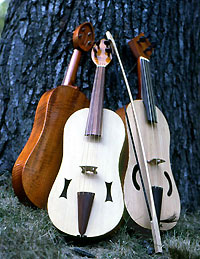
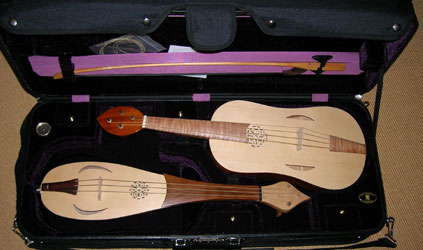
Putting a double violin case to good use with a rebec and fiddle that I built in 2007.
The Gemshorn, Gemsenhorn, or Corne de chamois
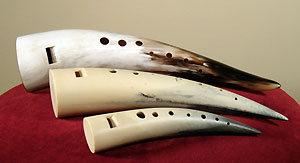 Depicted at the left are soprano, alto, and tenor (the largest) gemshorn. This instrument, which is depicted in some 16th-century sources, is generally considered to be medieval in origin, probably because it has a limited fange of only a ninth. For this same reason, it stop being used sometime during the Renaissance when musicians were searching for instruments with a wider range of both notes and tone colors. It has a very clean, medieval sound that makes people take notice. It can be compared to an Ocarina, except that it is perfectly in tune with itself and other instruments and can carry a melody in a really enchanting way. For more on the fascinating gemshorn, including a soundfile, please see my page The Gemshorn.
Depicted at the left are soprano, alto, and tenor (the largest) gemshorn. This instrument, which is depicted in some 16th-century sources, is generally considered to be medieval in origin, probably because it has a limited fange of only a ninth. For this same reason, it stop being used sometime during the Renaissance when musicians were searching for instruments with a wider range of both notes and tone colors. It has a very clean, medieval sound that makes people take notice. It can be compared to an Ocarina, except that it is perfectly in tune with itself and other instruments and can carry a melody in a really enchanting way. For more on the fascinating gemshorn, including a soundfile, please see my page The Gemshorn.